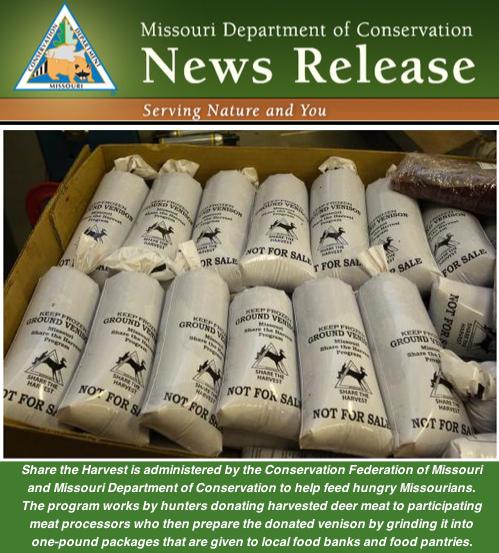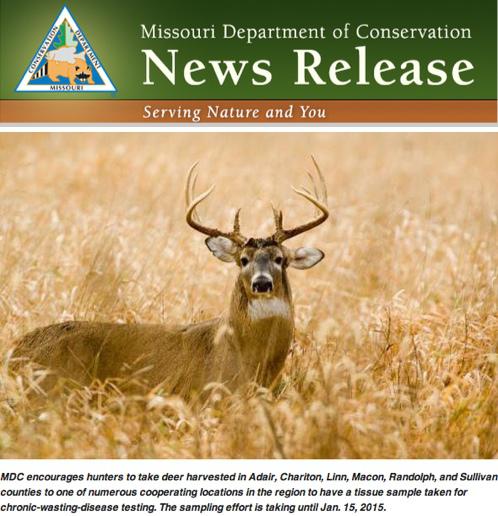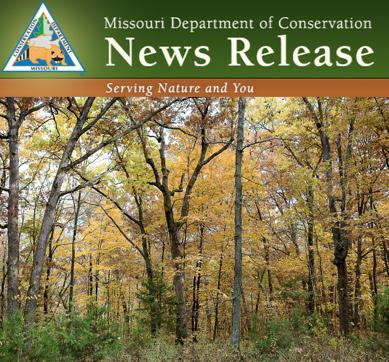Local News
It's Fire Prevention Week - Check Your Smoke Detector
October 08th 2014 by Dee Loflin

Fire Prevention Week 2014 -
Stresses Lifesaving Value of Smoke Alarms
Stresses Lifesaving Value of Smoke Alarms
'Working Smoke Alarms Save Lives: Test Yours Every Month!’ theme underscores the need for Missourians to install, regularly test smoke alarms for protection from house fires
Jefferson City, Missouri - Installing and maintaining smoke alarms in your home can make the difference between life and death and is why all Missourians are encouraged to use Fire Prevention Week, Oct. 5-11, to make sure their families are protected with smoke alarms.
“People need to understand how crucial smoke detectors are in fire safety and do all they can to have them in the home,” said Acting State Fire Marshal Greg Carrell. “Most home fire deaths occur where there are no working smoke alarms and about half of those deadly fires happen at night when people are asleep.”
Carrell said home fires often grow so quickly and produce so much smoke that people are often overcome before they can respond. Working smoke alarms can alert family members to the danger, providing enough time to safely escape.
To help make sure smoke alarms to work properly, replace smoke detector batteries at least once a year. Doing it at the same time each year, such as the return to Standard Time, when we set our clocks back an hour, makes it easier to remember. This year, Standard Time goes back into effect at 2 a.m. Sunday, Nov. 2. Smoke alarms should also be installed in every bedroom, outside all sleeping areas and on every level of the home, including the basement. Each device should be tested every month by pushing the test button and replaced as soon as they don’t work properly or when they are 10 years old.
The Division of Fire Safety suggests creating and practicing a family fire safety plan that includes home fire escape routes and establishing a location outside the home where family members are to meet if they become separated.
For more than 85 years, fire departments and the National Fire Protection Association (NFPA) have observed Fire Prevention Week, making it the longest running public health and safety observance on record. For more information on “Working Smoke Alarms Save Lives: Test Yours Every Month!” visit www.firepreventionweek.org.
Last Updated on October 08th 2014 by Dee Loflin
https://showmetimes.com/Blogpost/ust3/Its-Fire-Prevention-Week--Check-Your-Smoke-Detector
Republic Services Hosts Open House
October 07th 2014 by Staff Writer

Republic Services pulled back the curtains this past Friday as they hosted an informative, educational open house, complete with tours of their Dexter facilities. Guests were also treated to a BBQ lunch prior to being offered a tour.
More than 50 area business leaders, local residence and neighbors attended the open house and were offered a complete look into the past, a view of the present, and glimpse of the future of the Republic Services refuge collection operations. Kristie Greer, Marketing and Retention Vice President for Republic Services, was on hand to welcome guests and make introductions to Republic team members on hand for the event.
David Vasbinder, an environmental manager for Republic, was one of several tour guides outlining the current and future plans for the landfill. His in-depth knowledge was delivered in a very understandable discussion including long-term management strategies.
David Vasbinder, an environmental manager for Republic, was one of several tour guides outlining the current and future plans for the landfill. His in-depth knowledge was delivered in a very understandable discussion including long-term management strategies.
Republic Services is not a "new kid" on the block. The company is recognized nationally as an industry leader in the refuge collection and recycling arena. They are a very large company that holds true to their mission of being a local company staffed with a dedicated team of professionals.
 After announcing their purchase of Allied Waste in June of 2008 for $6.07 billion stock deal, Republic has continued to quietly and effectively execute a business model that embraces the local area. Originating as Lemons' Landfill and Hauling, the business was purchased by Allied Waste in 1993 and first issued the first "Subtitle D" landfill permit in April of 1994 by the Missouri Department of Natural Resources.
After announcing their purchase of Allied Waste in June of 2008 for $6.07 billion stock deal, Republic has continued to quietly and effectively execute a business model that embraces the local area. Originating as Lemons' Landfill and Hauling, the business was purchased by Allied Waste in 1993 and first issued the first "Subtitle D" landfill permit in April of 1994 by the Missouri Department of Natural Resources. The obvious question is 'how long will this facility be able to collect refuge before it becomes completely filled?' According to Mr. Vasbinder, the current area of the operation is nearing capacity. However, the company began seeking approval more than six years ago to open another area of the landfill for the future.
"This expansion should provide us with an additional 45 years of collection," noted David. "We are really proud of the progress that we have made over the past months to develop the roadways and begin to see the new area develop."
The critical importance of refuse collection is often taken for granted, or ignored, by area residents. The open house offered attendees the opportunity to board tour vans and travel the grounds of the facilities, seeing first hand the science and business model involved with the operational systems for the company.
 Vasbinder outlined the dedicated effort made by the company to return the land to an aesthetically pleasing property. Areas where the land had been terraced and grass seed was recently sown, returning it to a open grass field.
Vasbinder outlined the dedicated effort made by the company to return the land to an aesthetically pleasing property. Areas where the land had been terraced and grass seed was recently sown, returning it to a open grass field.So what ever becomes of the land that has been previously used as a landfill? Vasbinder gave examples of many community level possibilities that could exist in the future for these properties.
The economic impact is another important mission to Republic's investment into the local communities. The Industrial Development Authority of Stoddard County (IDASC) is the beneficiary of State statute requiring a tipping fee of $1.50 per ton of refuge. The funding is a significant revenue source allowing IDASC to attract new business and industry to Stoddard County.
The IDASC is organized to develop, advance and encourage economic development through the promotion of commercial, industrial, agricultural and manufacturing facilities and tourism in Stoddard County, Missouri. They provide low interest loans to new businesses to generate additional jobs throughout the county.
The IDASC is organized to develop, advance and encourage economic development through the promotion of commercial, industrial, agricultural and manufacturing facilities and tourism in Stoddard County, Missouri. They provide low interest loans to new businesses to generate additional jobs throughout the county.

Last Updated on October 07th 2014 by Staff Writer
https://showmetimes.com/Blogpost/ussv/Republic-Services-Hosts-Open-House
Encourage Deer Hunters to Share the Harvest
October 06th 2014 by Dee Loflin

Help feed hungry Missourians by sharing your harvest.
Funds are available to help cover processing costs.
Funds are available to help cover processing costs.
Jefferson City, Missouri – Many Missourians need help with putting meat on the dinner table. Deer hunters can help by sharing their harvests through Missouri’s Share the Harvest program. Share the Harvest connects deer hunters with hungry Missourians through participating meat processors and local hunger-relief agencies around the state.
To participate, hunters simply take their harvested deer to one of more than 130 participating meat processors and let the processor know how much venison they wish to donate to the program. Hunters can donate a few pounds to a whole deer. The processor will package the ground meat, which will be given to local charitable agencies for distribution to hungry Missourians.
The program is administered by the Missouri Department of Conservation (MDC) and the Conservation Federation of Missouri (CFM).
The National Institutes of Health state that children need protein in their diets for proper growth and development, and adults need it to maintain good health. Yet many Missourians and their families can't afford or can't get good sources of protein. Deer meat, or venison, is a local source of much needed lean protein.
“Conservation makes Missouri a great place to hunt for more than 500,000 deer hunters who harvest more than 200,000 deer each year,” said MDC Director Bob Ziehmer. “By sharing part of their harvest, these deer hunters can help feed many hungry Missourians in their communities.”
Since 1992, Missouri hunters have donated more than 3.1 million pounds of venison to the needy through Share the Harvest. In 2013, nearly 4,500 hunters donated more than 227,000 pounds of venison.
"Throughout history, hunters have provided for their communities,” said CFM Director Brandon Butler. “Share the Harvest continues that tradition. Hunters who donate a deer to the Share the Harvest program are making a positive impact in the lives of their fellow Missourians.”
Funds are available to help with processing costs when a whole deer is donated during all portions of the archery and firearms deer seasons. CFM reimburses processors a predetermined amount for each whole deer donated. This allows processors to reduce processing fees to hunters.
Statewide sponsors of the cost-reduction program include MDC, CFM, Shelter Insurance, Bass Pro Shops, Missouri Chapter of Safari Club International, Missouri Chapter of National Wild Turkey Federation, Midway USA Inc., Missouri Food Banks Association, United Bowhunters of Missouri, Missouri Trappers Association, and Missouri Hunter Education Instructors Association.
In addition, many processors have local money available that allows deer to be processed for free or at reduced cost. The cost of processing the deer is the hunter’s responsibility when local funds to help cover the full cost are not available. Be sure to contact individual processors to determine if local funds are available.
To find participating processors or to learn more about the program, visit the MDC website at mdc.mo.gov/hunting-trapping/deer/share-harvest.
MDC’s 2014 Fall Deer & Turkey Hunting Regulations and Information booklet also lists participating processors. Get it at MDC offices and nature center, where hunting permits are sold, and online at mdc.mo.gov/sites/default/files/resources/2010/03/ftd2014.pdf.
For more information on Share the Harvest and how you can help support the program, visit the CFM website at http://confedmo.org/programs/outreach/share-the-harvest/#.
Last Updated on October 06th 2014 by Dee Loflin
https://showmetimes.com/Blogpost/ussl/Encourage-Deer-Hunters-to-Share-the-Harvest-
MDC Reminds Deer Hunters to Properly Dispose of Carcasses
October 02nd 2014 by Dee Loflin

“Conservation makes Missouri a great place to hunt deer, and deer hunters are key to keeping it that way,” says MDC Deer Biologist Jason Sumners. “Because many hunters process their own deer, they are key players in slowing the spread of diseases such as CWD. One way that disease can spread is by the transportation and improper disposal of carcass parts.”
Deer can become infected with chronic wasting disease if they come into contact with other infected deer or with surface soil containing carcass parts from diseased deer. Deer carcass parts known to concentrate CWD include brain, spinal cord, eyes, spleen, and lymph nodes.
Chronic wasting disease was first found in Missouri in Macon and Linn counties several years ago. In response, MDC established a CWD Containment Zone covering Adair, Chariton, Linn, Macon, Randolph, and Sullivan counties. The disease remains limited to the local area.
“Hunters who harvest deer in these counties should not take whole deer carcasses out of the containment zone, or carcass parts that contain brain, spinal cord, eyes, spleen, or lymph nodes,” Sumners adds, along with the following information.
Proper Carcass Disposal
Avoid cutting through bones, spine, or brain when processing deer carcasses.
Remove meat in the field and leave the carcass behind. Bury it if possible.
If processing harvested deer in camp or at home, place carcass parts in trash bags and properly dispose of them through a trash service or landfill.
Take harvested deer to a licensed commercial processor to assure proper carcass disposal.
For taxidermy work, use a licensed taxidermist to assure proper carcass disposal.
Safe Parts to Transport
Meat that is cut and wrapped, or has been boned out,
Quarters or other portions of meat with no part of the spine or head attached,
Hides or capes from which all excess tissue has been removed,
Antlers, including antlers attached to skull plates or skulls cleaned of all muscle and brain tissue, and
Finished taxidermy products.
The Wildlife Code of Missouri requires hunters who harvest deer, elk, or moose out of state and bring the animal with the spinal column or head attached into Missouri to call toll free, 877-853-5665, and report the animal’s entry within 24 hours. They also must take the carcass to a licensed meat processor or taxidermist within 72 hours of entry. This is designed to prevent introducing CWD into new areas of Missouri from other states. Hunters transporting deer through Missouri en route to other states do not need to call the number.
Donate Tissue Samples
Sumners also encourages hunters who harvest deer within the CWD Containment Zone of Adair, Chariton, Linn, Macon, Randolph, and Sullivan counties to donate tissue samples from their deer to the Conservation Department for its CWD monitoring program. Numerous deer-processing facilities and taxidermists in the area are participating in the effort.
Details about these measures are listed in the 2014 Fall Deer & Turkey Hunting Regulations and Information booklet, which is available at MDC offices and nature centers, where hunting permits are sold, and online at mdc.mo.gov/sites/default/files/resources/2010/03/ftd2014.pdf.
Last Updated on October 02nd 2014 by Dee Loflin
https://showmetimes.com/Blogpost/usqg/MDC-Reminds-Deer-Hunters-to-Properly-Dispose-of-Carcasses
Fall Color Report for Missouri
September 26th 2014 by Dee Loflin

Leaves turn colors when two things happen. First, sugars produced by photosynthesis are trapped inside leaves by chilly - but not freezing - autumn nights. Those sugars are the building blocks for red, yellow, orange, and purple pigments. Cool nights simultaneously cause the breakdown of green pigments, allowing these other colors to show through.
Missouri’s fall color starts in late September and usually peaks in mid-October. This progression of color change starts earliest in northern Missouri and moves southward across the state. Normally by late October, colors are fading and leaves are beginning to drop from trees. Generally, color change is predictable, but can vary year to year, depending on weather.
According to Missouri Department of Conservation Forestry Field Program Supervisor Nick Kuhn, autumn weather will be the biggest factor affecting this year’s fall color.
“It has been a decent year for most trees,” says Kuhn. “Sufficient rain, moderate temperatures, no serious insect problems, or weather events means trees are happy and doing OK. The fall weather will be the major factor in showing us those wonderful hidden colors in all trees. Watch for sunny days and cool nights with no frost to know when to start looking for color changes. I predict that across the state, the best week for fall color change will be the last week of October.”
The Conservation Department provides weekly fall-color reports and has developed a free mobile app to help Missourians discover fall color around the Show-Me State. The report combines information from foresters around the state in weekly online updates at mdc.mo.gov/node/4548 from late September through November.
The Conservation Department’s free MO Fall Color application is available for smart phones and other mobile devices. It provides up-to-the-minute fall-color scenes from around the state, complete with GPS navigation information. The app also provides weekly fall-color reports for various areas of the state. Users can even add their own fall-color photos and share them with Facebook friends and others. The MO Fall Color app is active during fall-color changes beginning in September through November. Download MO Fall Color for Android and Apple devices at http://mdc.mo.gov/node/19321.
Last Updated on September 26th 2014 by Staff Writer
https://showmetimes.com/Blogpost/usp2/Fall-Color-Report-for-Missouri-

